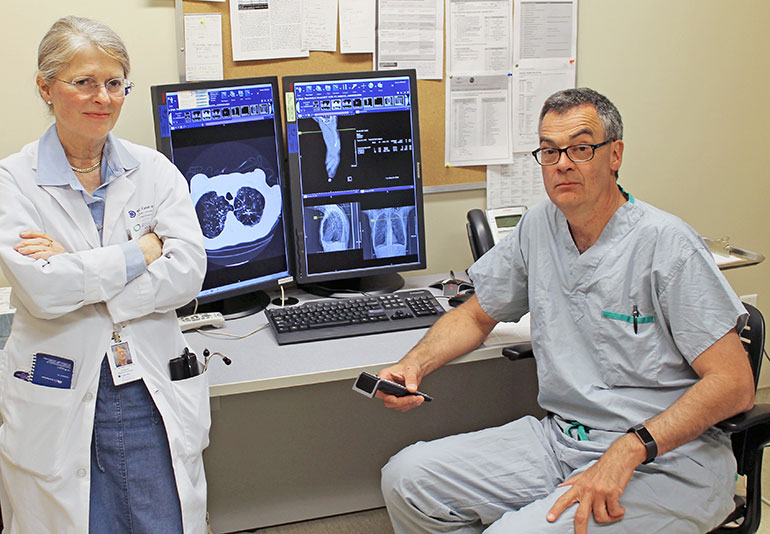
Drs. Michael Humer and Barbara Campling are part of a thoracic oncology team that treats cancer patients via telemedicine.
Virtual clinics provide improved access to medical services for cancer patients
New UBC research shows that telemedicine dramatically improves access to quality medical care in small and rural BC communities—while saving time, money and travel risk for patients.
The Interior Health Thoracic Surgery Group (IHTSG) of Drs. Shaun Deen, Michael Humer, Anand Jugnauth and Andrew Luoma represents a team of thoracic surgeons based at Kelowna General Hospital. Collectively, they serve a population of more than one million British Columbians dispersed across 807,000 square kilometres in the Interior and North regions of the province.
About 80 per cent of IHTSG patients have cancer, most commonly in the lung or esophagus, according to Dr. Humer, lead author of the study and clinical assistant professor with the Southern Medical Program based at UBC Okanagan. Through the use of a robust, secure Skype-like videoconference technology, Humer describes how thoracic surgeons provide patient-centred care to communities in the far reaches of the province.
“In one day, I can see patients in Kamloops, Prince George, Dawson Creek, and Oliver, review their medical images in real time and determine appropriate treatment plans,” says Humer. “It’s often better than seeing the patient ‘in-person’ as I now see them with a family member who might not have been able to travel to Kelowna.”
Between 2003 and 2015, the IHTSG conducted 15,073 telemedicine appointments from 63 different geographic locations. These same patients saved a total travel distance of 11.5 million kilometres, an average of 766 kilometres per patient.
“Our telemedicine program began in 2003 due in large part to the efforts of my late colleague Dr. Bill Nelems,” says Humer. “It has grown from 320 patients in the first full year to more than 1,700 patients annually across the Interior and Northern Health coverage areas.”
Telemedicine now represents 40 per cent of the Kelowna service’s practice, enabling surgeons to seamlessly provide consults and follow-ups with the few clicks of a button. Patients need only come to Kelowna if they require surgery. This greatly reduces the amount of travel time on BC’s mountainous highways, especially treacherous during the long winter months.
“The patient feedback we’ve received really highlights the tangible benefits of telemedicine,” says study co-author Dr. Barbara Campling, head of Medical Oncology at the BC Cancer Agency in Kelowna and clinical professor with the UBC Department of Medicine. “Patients, especially those that are elderly, are grateful to receive quality care but be spared the cost and stress of a multi-hour trip.”
Both Humer and Campling credit the commitment and support of Interior Health and the extensive collaboration with health professionals, office staff, and IT specialists across both health authorities in ensuring the timely and reliable delivery of the telemedicine service.
The research was recently published in Current Oncology Reports.
About UBC’s Okanagan campus
UBC’s Okanagan campus is an innovative hub for research and learning in the heart of British Columbia’s stunning Okanagan Valley. Ranked among the top 20 public universities in the world, UBC is home to bold thinking and discoveries that make a difference. Established in 2005, the Okanagan campus combines a globally recognized UBC education with a tight-knit and entrepreneurial community that welcomes students and faculty from around the world. For more visit ok.ubc.ca